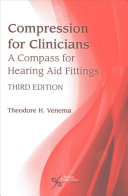

Most ebook files are in PDF format, so you can easily read them using various software such as Foxit Reader or directly on the Google Chrome browser.
Some ebook files are released by publishers in other formats such as .awz, .mobi, .epub, .fb2, etc. You may need to install specific software to read these formats on mobile/PC, such as Calibre.
Please read the tutorial at this link: https://ebookbell.com/faq
We offer FREE conversion to the popular formats you request; however, this may take some time. Therefore, right after payment, please email us, and we will try to provide the service as quickly as possible.
For some exceptional file formats or broken links (if any), please refrain from opening any disputes. Instead, email us first, and we will try to assist within a maximum of 6 hours.
EbookBell Team

4.4
62 reviewsCompression for Clinicians: A Compass for Hearing Aid Fittings, Third Edition explains many developments that have taken place in the world of hearing aid compression, fitting methods, and real ear measurement. The text aims to make difficult concepts easier to understand and to explain in plain language many topics pertaining to compression. Directional microphones and digital features of noise reduction, feedback reduction, and expansion are also covered. The third edition recognizes two distinct clinical populations of sensorineural hearing loss: mild to moderate, on one hand, and more severe, on the other. These two clinical populations are well served by a corresponding pair of compression types: wide dynamic range compression and output limiting compression. Another double distinction held throughout the text is the two-part task for all hearing aids: providing gain and also increasing the signal-to-noise ratio. Gain is addressed by compression, while listening in noise is addressed by directional microphones and digital noise reduction.
New to the Third Edition
Compression for Clinicians is intended for those studying to become hearing health care professionals, including audiologists and hearing instrument practitioners. It is also intended for practicing clinicians who simply want to refresh their knowledge base concerning hearing loss and hearing aids. Clinically relevant and very thorough, it provides a compass in th